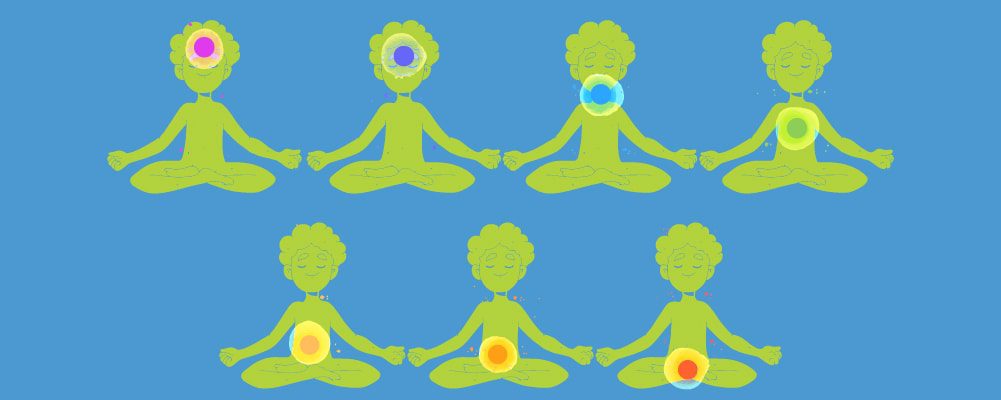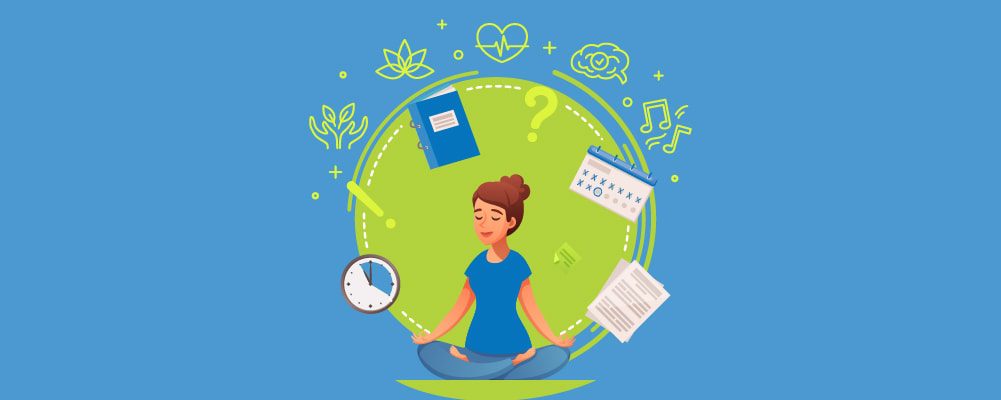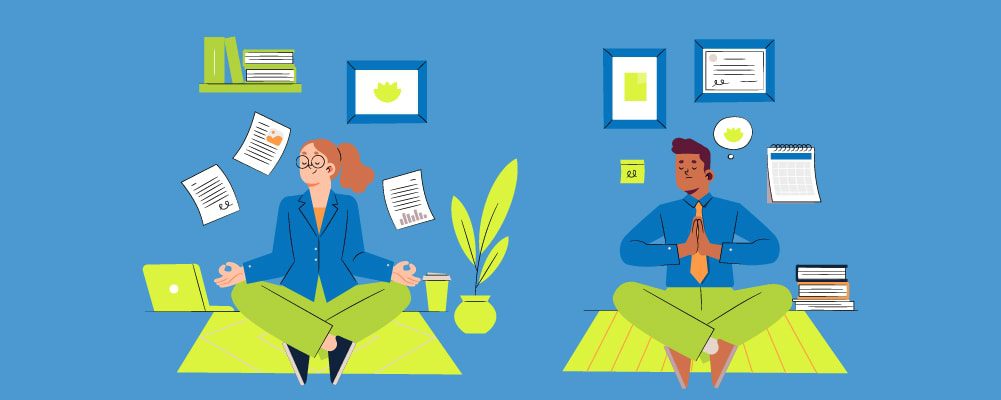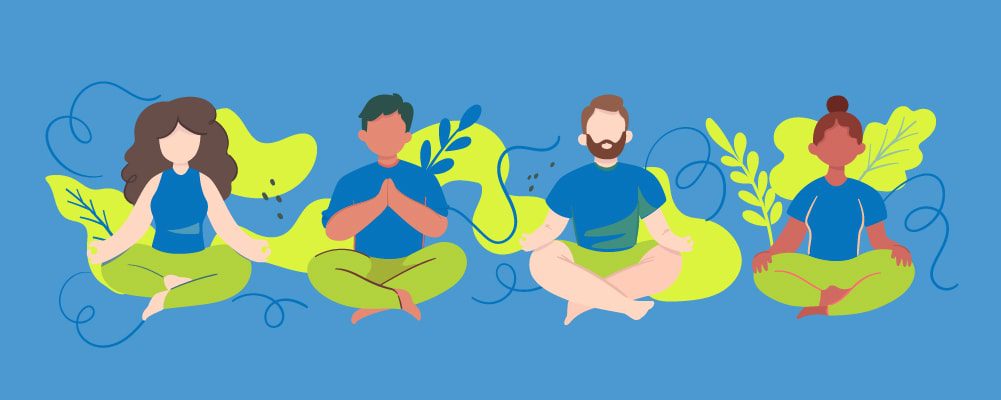Find out all about the benefits of meditation, how to practice meditation, and how to start a good habit of a lifetime in this beginner’s guide to the benefits of meditation.
Introduction

Meditation has been practiced by many different cultures for thousands of years and is associated with a number of positive mental and physical health benefits, including reducing stress, improving your quality and quantity of sleep, and increasing your ability to focus.
Like with all good habits, however, it can be difficult to get into the practice of meditation.
Despite knowing that meditation has all of these benefits, and knowing that we’ll most likely feel better both physically and mentally if we set as little as 10 minutes aside to practice, without understanding the full effect of these benefits, it can be difficult to find the motivation.
To help light a fire under your yoga mat, we’ve put together this beginner’s guide to meditation and its benefits so that there will be no excuses left for you not to start!
[toc]
What is Meditation?

Meditation is essentially a relaxation technique. It’s practiced through a combination of controlling your breathing and calming the mind until you’re able to exist in the present.
Originating from Eastern traditions over 3,000 years old, in 2016 it was estimated that approximately 9.3 million US adults have practiced meditation.
If you’re stressed or generally struggling with your mental well-being, meditation can help release the stresses of the day and helps you achieve inner peace to ease any inner turmoil.
Meditation is accessible to anyone and everyone, whether you’re young or old, active or out of shape, rich or poor. There is no special equipment involved and learning how to meditate is easy, so you can practice pretty much wherever you decide to lay your yoga mat!
There are also several different types of meditation practice, including the ones we’re about to discuss in this next section. After having explored and developed a deeper understanding of the basic principles of meditation you can choose which style you’d like to practice.
Mindfulness Vs. Meditation
Many people assume that meditation is all about concentration but the opposite is true. In actual fact, meditation focuses on de-concentration and emptying the mind of all thoughts.
Mindfulness, however, fits this assumption a little more accurately. This is the practice of paying attention to your thoughts and trying to understand them rather than let them go.
You necessarily have to meditate in order to be mindful, as this can be achieved by simply allowing yourself to become attuned to your surroundings and focusing on the task at hand. With that being said, meditation is the intentional practice of being mindful.
According to Insider, mindfulness meditation “is the most common type of meditation in the West – and perhaps the easiest one to start.” Put simply, it’s all about paying attention to your current state of awareness and the emotions you’re experiencing in the present moment.
Guided Meditation
If you’re new to meditation, you may find it helpful to start off by trying guided meditation.
This is a method of meditation in which you’re guided by a teacher, either in person, through audio, or via video. Your teacher will be able to help you open your mind and it can be useful to have someone who’s experienced with meditation lead you through your first time.
There are plenty of free videos on Youtube that allow you to choose meditation for a specific purpose or there are apps such as Headspace which offers both paid and free subscriptions.
However, this will ultimately come down to personal preference, as some people find that hearing another person’s voice during meditation distracts them from their intended purpose.
Body Scan Meditation
Remember we keep mentioning that meditation has physical as well as mental benefits? For many people, stress can manifest as physical problems in the body, such as headaches, heartburn, general aches and pains, and tension in your back and shoulders, to name a few.
Rather than allowing your mind to empty itself, in body scan meditation, you pay particular attention to your body, starting with your feet. Mostly, the aim of this form of meditation is to do exactly what it suggests and scan your body from head to toe – or rather, toe to head.
Body scan meditation therefore allows you to check in with your body bit by bit as you focus on how it is feeling. Not only can this help you recognize any physical discomfort you may be experiencing that you otherwise may not have noticed, but it can help you relax as well.
Walking Meditation
For a lot of people, when they picture how meditation practice looks in their mind, they will imagine you sitting and resting peacefully, eyes closed, in a calm and comfortable position.
You might therefore be surprised to learn about walking meditation which is an equally valid and effective method of meditation. When was the last time you went for a walk without listening to music or a podcast, or without phoning a friend to chat to while you walk?
Walking meditation forces you to stay present and allows you to connect with the world around you rather than becoming lost in thought and let your legs move on autopilot.
Similar to body scan meditation, walking meditation aims to bring your body and mind together in sync with the world and nature that you’re surrounded by. This can include but is not limited to the following techniques:
- Count your steps and, once you’ve reached a specified number, turn around with intention and walk back to your starting position.
- Focus on bringing your foot up and letting it fall to the ground again with each step that you take. Pay attention to how your body moves and whether you sway slightly from side to side – try to balance yourself if you notice this happening.
- Keep returning your focus and attention to the act and sensations of walking.
- If walking outside, be mindful and acknowledge the surroundings in your environment as you walk by.
Loving Kindness Meditation
The importance of self-love is well known these days with specific movements for body positivity and learning to put yourself first. This can go hand-in-hand with meditation which is how loving kindness meditation was born.
Although it might sound a little hippy-ish, there are several psychology studies that demonstrate how self-love and being kinder to oneself can be hugely beneficial to your mental well-being, helping you manage conditions such as depression or anxiety.
Loving kindness meditation can help cultivate these feelings of self-love and acceptance as you focus on being kinder to yourself and others which makes for harmonious relationships.
Some techniques that are commonly used in loving kindness meditation include:
- Remind yourself of your achievements or of things that you like about yourself.
- Repeat positive affirmations or phrases that you would like to remind yourself of, such as “I will be happy” or “I will let go of negative thoughts”.
- Be kind to yourself and don’t beat yourself up if you notice that your mind has started to wander or if you can only manage a short period of time before ending your meditation practice.
Benefits of Meditating

One of the reasons behind its increasingly widespread popularity in recent years is because there are several science-based benefits of meditation that can range from having a positive effect on your mental well-being to plenty of physical benefits that affect your body.
This next section will walk you through some of the most well-known benefits of meditation.
It’s important to keep in mind, however, that some of the benefits associated with mediation will only become apparent after you’ve been practicing meditation consistently for a while.
Don’t be discouraged if you’re not necessarily feeling the benefits of meditation after your first few practices and allow yourself to just enjoy these times of calm and peacefulness for what they are, and shortly, the benefits of this will follow.
Reduced Stress
With the capitalist and societal pressures of today, it’s no wonder that Americans are feeling more stressed than ever. Studies have shown this to have been exacerbated by the recent pandemic during which 64% of employed adults cited work as a major source of stress.
This can affect multiple areas of your life, including sleep, mental well-being, fatigue, blood pressure, anxiety, and brain fog.
Meditation, however, can help combat these symptoms of stress and helps to reduce feelings of stress overall which is one of the main reasons more people are turning to meditation as a way to try and improve their mental well-being.
According to research on meditation use among US adults, “anxiety (29.2%), stress (21.6%), and depression (17.8%) were the top health problems for which people used meditation” and “63.6% reported that meditation had helped a great deal with these conditions.”
Improved Focus and Concentration
Another benefit of meditation is that it can help you improve your levels of focus and concentration which is particularly ideal if you’re studying for exams or going through a busy period at work.
Meditation is based around building on your ability to focus on yourself and your environment, so think of it like weight lifting but for your brain. The more you practice your concentration during meditation, the better you will be able to concentrate in general.
In fact, studies have shown that people who regularly practice meditation were able to “perform better on a visual test and had a greater attention span than those without any meditation experience”, according to an article for Healthline.
This could also be because meditation helps quiet any voices of worry or anxiety in your head as these could be contributing to your lack of ability to focus.
Improved Sense of Well-Being
Certain forms of meditation can help improve your relationship with yourself and having a better sense of self of well-being can have many benefits in and of itself.
Your sense of well-being can benefit from a bit of meditation as this can help to reduce negative thinking as well as allowing you to focus on the present moment rather than potentially stressing or worrying about things that are beyond your control.
In most cases, this will improve your quality of life which is another benefit of practicing meditation. This was demonstrated in a study that looked at a group of employees and asked some of them to use a mindfulness meditation app for an 8-week period.
The results of this study showed that the group who participated in regular meditation “experienced improved feelings of well-being and decreased distress and job strain, compared with those in a control group” who did not practice regular meditation.
Better Self-Esteem
Self-esteem is linked to our feelings of self-worth and can influence how we value or feel about ourselves. These feelings can then manifest as thoughts that we tell ourselves on a daily basis and can be either positive or negative based on how much self-esteem we have.
Meditation can be hugely beneficial if you’re experiencing a period of low self-esteem as it’s the practice of letting go of negative thoughts and feelings and embracing yourself as you are in the present moment. It can even help change your relationship with your thoughts.
Often, it can be a struggle to wade through all of your negative thoughts if you have low self-esteem, but meditation allows you to practice exactly that. The next time you’re struggling to see past the negativity, you can use meditation techniques to help push past it.
As explained by Headspace so well, “through meditation, we experience thoughts, but we are able to recognize them as passing. Instead of identifying with them or using them to reinforce an old storyline in our mind, we simply let them go” leaving room for more positivity.
Visualize Your Higher Self
Seeing as meditation allows us to transcend our thoughts and feelings after recognizing and acknowledging them, with enough consistency, meditation also has the benefit of being able to help you visualize and connect with your higher self.
Meditation is just one of the ways you can work on fostering the connection and strengthening the relationship between you and your higher self, as it allows you to open a dialogue without the distraction of daily interruptions or intrusive negative thoughts.
Aids Manifesting Techniques
If you haven’t already read the Secret, you should definitely add it to your “to be read” pile.
It’s a book about the power of manifestation and how this practice can impact your life. Meditation can aid several manifesting techniques including visualization, which is where you hold an image in your mind that you would like to achieve before it has happened.
Not only can this help to reduce performance anxiety as you’ll already feel familiar with the scene at hand, but a large number of people believe that by manifesting and putting these positive affirmations out into the universe, there is more chance that they will happen.
Before Meditating

As we mentioned earlier, the practice of meditation is a simple one, but there are a few things you can do before meditating to ensure that you have a good session.
Pick a Peaceful Environment
It’s important to try and find a quiet space somewhere where you’re unlikely to be disturbed during your meditation practice. Whether you choose an indoor or outdoor environment, find somewhere comfortable and peaceful that’s far away from the noise of other people.
It can also be a good idea to turn on airplane mode on your phone to further minimize distractions.
Wear Comfortable Clothing
In order for your mind to be completely free, it’s best to keep any potential distractions to a minimum, which includes scratchy or uncomfortable clothing that you feel the need to fuss with during your meditation practice.
Instead, wear non-restrictive, comfortable clothing as this will allow you to breathe deeply as is required during meditation and to focus better.
Decide How Long to Meditate For
There’s no set length of time that you should meditate for which is ideal for those with busy schedules who are worried about squeezing a session of meditation practice in.
Whether you’re intending to meditate for 10 minutes or half an hour, decide how long you’re going to meditate for and try to stick to a similar routine to start with to help build the habit.
Stretch Beforehand
It’s advisable to stretch before you begin meditating as this can help to loosen and relax your body which allows you to focus on the thoughts in your mind instead.
There are a number of hip stretches that prepare you for sitting meditation or alternatively, you could choose to focus on your breathing techniques before you start meditating.
How to Meditate

Although meditation isn’t necessarily complicated, if you’re not sure where to start, it can sometimes feel like you’re just sitting down pointlessly albeit comfortably, so this next section will walk you through some of the key things to know about how to meditate.
Get Comfortable
Once you’ve chosen your quiet spot for meditation, it’s time to get comfortable.
This can mean bringing a cushion with you to sit on top of if the ground beneath you is hard or you can even meditate from a chair. There are no rules in this sense, so do whatever you need to ensure that your body is relaxed and your body is free to focus.
Straighten Spine
It can take some practice before you’re able to naturally assume a posture with a straight spine due to the modern need to work hunched over a computer screen or a mobile device.
When meditating, you should straighten your spine and elongate your neck which will open up your chest for better breathing techniques. You can learn to straighten your spine by:
- Imagine your head is being held up by a piece of string.
- Picture the vertebrae in your spine being stacked on top of each other.
- Try to embody a tree or mountain in your sitting position.
Focus and Relax
There are a few different techniques that you can use to help yourself focus and relax, including the following exercises.
You can use a combination of these relaxation techniques or one alone, but we’d recommend trying a few different methods if you find that you’re still struggling to focus. Experiment with which technique works best for you and use it during your meditation.
Breathing
Relaxed breathing is a technique that involves “deep, even-paced breathing using the diaphragm muscle to expand your lungs. The purpose is to slow your breathing, take in more oxygen, and reduce the use of the shoulder, neck, and upper chest muscles while breathing so that you breathe more efficiently”. This can be useful in meditation as it helps you to relax.
Mental Images
If you’re struggling with your focus and concentration skills during meditation, it can be helpful to paint a picture of a particularly relaxing place or scene in your mind.
This doesn’t have to be limited to the sense of sight, either. As advised by an article from Mayoclinic.org, you should “try to use as many senses as possible, such as smells, sights, sounds, and textures” which may be easier to achieve with the help of a guide or teacher.
Repeat Mantras to Help Focus
During meditation, you can repeat certain words, phrases, or mantras that aid your focus. You should think the words silently rather than speak them aloud and this can be a great way to prevent distracting thoughts from taking over and directing you off track.
There are plenty of religion-based mantras that would be suitable for this type of meditation, or you can simply repeat works of affirmation that have strong meaning to you.
Practice Visualization
A good way to get your brain to stay on track when you’re trying to focus or concentrate is to visualize what it is you want to be thinking about. If you’re attempting to clear your mind, it could be helpful to picture a calm, relaxing scene such as a beach or a forest glade.
According to Van Alstyne, your focus will be “on engaging your imagination and actively creating imagery in your mind” which is a better technique to try if you struggle with creating a completely blank canvas for your thoughts.
Use Music to Help Relax
Music can help you focus by tuning out the distractions around you so your mind has fewer thoughts to combat before you can relax fully. It doesn’t matter what type of music you’re listening to as long as it’s bringing you comfort and you find it relaxing.
This can also be a good alternative for those who struggle to sit with their own thoughts in complete silence without them wandering from one topic to another. Having relaxing music in the background while you meditate will therefore help you focus and can be more enjoyable.
Nature
Unsurprisingly, allowing yourself to be at one with nature can be another useful way to improve your focus and concentration during a meditation session.
There are some excellent nature-based meditation practices you can do which have the benefit of helping you to reconnect with the natural world and let go of the societal stresses and pressures that could be impairing your ability to concentrate and focus fully.
Basic Meditation for Beginners

Here are 6 key tips to focus on for beginners if you’re new to meditation:
- Breath: Instead of trying to force your mind to be calm and focusing all your energies on preventing your mind from wandering, simply recognize when this happens and gently return to appreciating the small wonders around you, from your breathing to the sensations you may be feeling throughout your body.
- Arms: Before you begin your meditation, try to make sure that your arms, shoulders, and neck are relaxed, as these are all areas that can hold tension when you’re stressed or feeling burnt out. Rest your hands on top of each other in your lap.
- Eyes: It’s not an essential requirement, but it can be beneficial to close your eyes during a meditation session to help your focus and to block out any distractions. This will depend on your personal preference, however, as keeping your eyes closed tends to result in a more body-focused meditation whereas keeping your eyes open can help you to feel more connected to the space around you.
- Legs: Depending on the sitting position you’re in, either ground yourself by keeping your feet on the ground and using this to anchor yourself while you straighten your spine, or by crossing your legs if you’re sitting on a cushion on the floor.
- Time: When you’re still starting out with meditation, try not to think too much about time. Meditation isn’t more effective the longer you practice it for and it’s not about the length of time you dedicate to a single session. Consistency is more important than quantity! Think about when you’re building muscle at the gym – weight lifting once for 3 hours won’t work, you’ll need to practice and grow your muscles over time.
- Emotions: Similarly, don’t be disheartened if you’re not able to immediately banish every negative emotion from your mind within your first meditation practice. Instead, you will learn to cultivate more positive emotions and regulate your mood.
Making Meditation a Habit

The best way to create a habit from anything is to build it into your existing routine by establishing a time and place to consistently practice meditation.
It’s important to remember that habits aren’t formed overnight, even with the best will in the world, so try not to be too hard on yourself and don’t beat yourself up if you miss a session.
Pick a Time
If you know you usually have an hour between meetings on a Monday morning, for example, why not dedicate 20 to 30 minutes of this time to squeezing in a quick meditation session? This will help you to establish a routine and you’ll begin to expect it each week.
Alternatively, some people find that meditating in the morning first thing after they wake up is the best time to implement it into your daily routine. This can help set you up for the day ahead as well as helping you move past any stresses from the previous day.
The opposite option is to practice meditation right before you go to bed. Similarly, this can help you let go of any negative thoughts or feelings from earlier in the day while you mentally prepare yourself and set yourself up for tomorrow, which makes for a more relaxing sleep.
Choose a Spot
Similarly, having a dedicated spot in which to practice meditation can also help to build the habit of taking the time to do it.
Opt for somewhere that is quiet with few distractions, which means having no television or telephones nearby. As you improve and become more skilled at meditating, you may find that distractions are less noticeable and that you’re able to block them out with your mind.
In this case, you can take up meditation in a wider variety of locations which can be particularly beneficial if you find yourself in a high-stress situation as it allows you to practice meditating in situations where you need it most, like in large crowds or when stuck in traffic.
Summary

As you can see, there are numerous benefits associated with meditation, especially today as the pressures of modern society build up and it feels like you have the weight of the whole world’s problems on your shoulders.
Remember, humans were never built to process the amount of knowledge we now have access to at the mere touch of a button, so meditation can be a great way to escape and take things back to basics.
We hope this article has helped teach you all about the basics of meditation, the different types of meditation practices there are for you to choose from, and of course, how meditation can benefit you.

